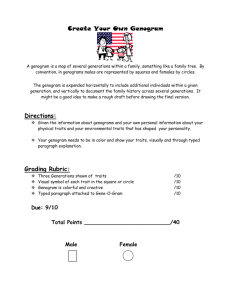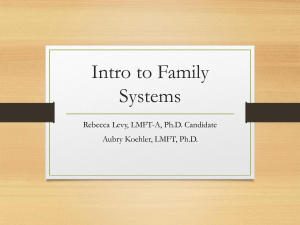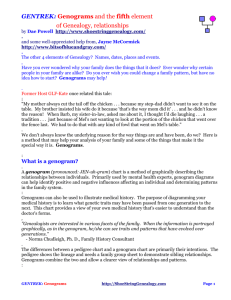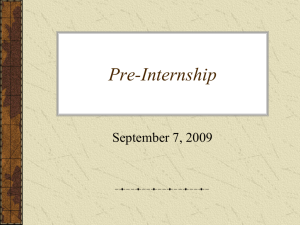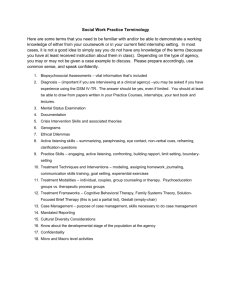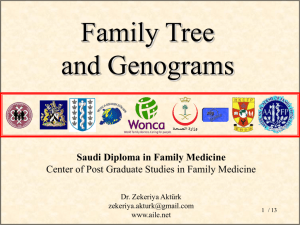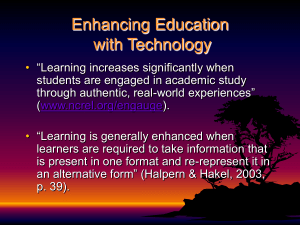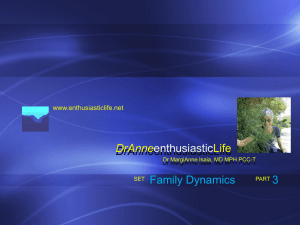Marriage and Family Dynamics
advertisement
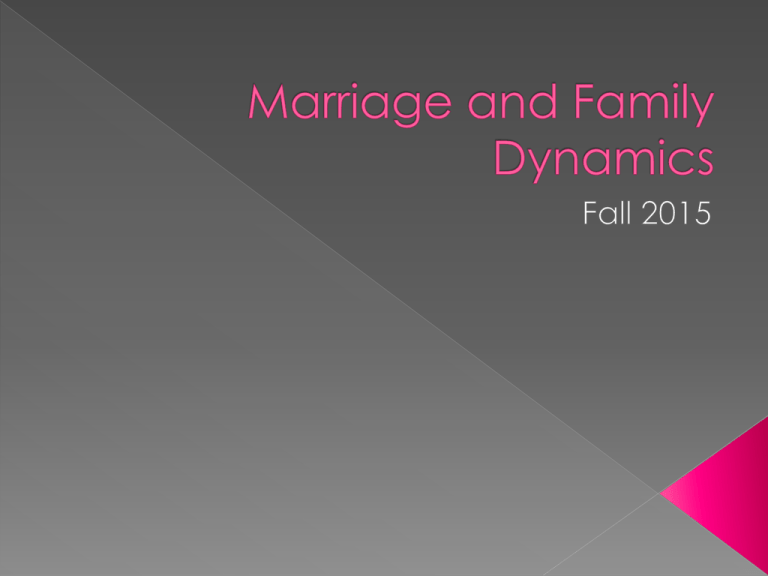
In pairs, answer the following questions and turn in one written response with both names on paper. Use Goldenberg, Yarhouse, and Genogram books) 1. After reading Box 1.6 Case study, p. 18 (Goldenberg), create a genogram of family and identify where presenting problem is taking place 2. What skills and concepts mentioned in Ch. 1 were used to facilitate change in this family? 3. If this family requested biblically informed counseling, what concepts from Ch. 1 (Yarhouse) would be useful to bring into the session? The standardized genogram format is becoming a common language for tracking family history and relationship Record information about family members and their relationships over at least three generations. Provides a quick gestalt of complex family patterns. Map family structure and update as patterns and functioning emerge. Created at any moment in the family’s history, showing the ages and relationships of that moment to better understand family patterns as they evolve through time. Should be part of any comprehensive clinical assessment, if only to know who is in the family and facts about their current situation. Basic demographic information Multigenerational mapping (Bowenian) Systemic hypothezing for strategic interventions Projective hypotheses about the workings of the unconscious. Time-line genograms Functional families Attachment diagrams Spiritual/religious genograms Complex relational configurations – remarried families Engaging and tracking of complex, culturally diverse families Exploring specific issues such as sexuality and sexual history of the family Making family interventions Teaching illiterate adults to read Work and career genograms to facilitate career decision Gender relationships over the life cycle. Haley: He said he did not believe in ghosts Minuchin, Watzlawick, Weakland, and Sluzki – preferred to focus on the relationships in the immediate family Michael White – saw gathering information as problematic – it “privileges” certain family of origin experiences over other relationships, which may disqualify or fail to honor these other people. Articulating historical patterns can reveal aspects of the family that have been hidden from family members – “Secrets” Leads family beyond the onedimensional linear perspectives that have so often characterized psychological explanations. Teaches people to think systematically – patterns – noticing more than one pattern at a time See page 12, fig. 1.3, fig. 1.4 SES Gender/Sexual orientation Culture/Ethnicity/Race Geopolitical structure Religion/Spirituality Guides clinicians in using genograms for clinical assessment and intervention Family members are intricately intertwined in their lives and in death All of society is ultimately interconnected. People, problems, solutions, do not exist in a vacuum. “ No one goes anywhere alone, even those who arrive physically alone….We carry with us the memory of many fabrics, a self soaked in our history and our culture.” Those who are tied together through their common biological, legal, cultural, and emotional history and by their implied future together. Where you fit in the family structure and large context, can influence your functioning, relational patterns, and the type of family you form in the next generation. Families repeat themselves. See fig. 1.5 Context for assessing problems Key words: Nuclear family p.5 Blended family (Step family) Family interactive patterns Shared family rituals Family narratives – Box 1.1 Postmodern outlook Family resiliency Positive psychology Therapist resilience Cultural diversity Box 1.5 Epistemology Monad Dyad/Triad Cybernetics Reciprocal Determinism Constructivist perspective Identified patient Table 2.2 Stages of the Family Life Cycle (6) Table 2.3 Common transition points (Duval) (8) Family life cycles – multidimensional, multicultural, multigenerational perspective Fig. 2.1 Box 2.2 – Discuss in triads. Binuclear family Table 2.5 – Stages – Divorcing families Remarried families LGBT families
